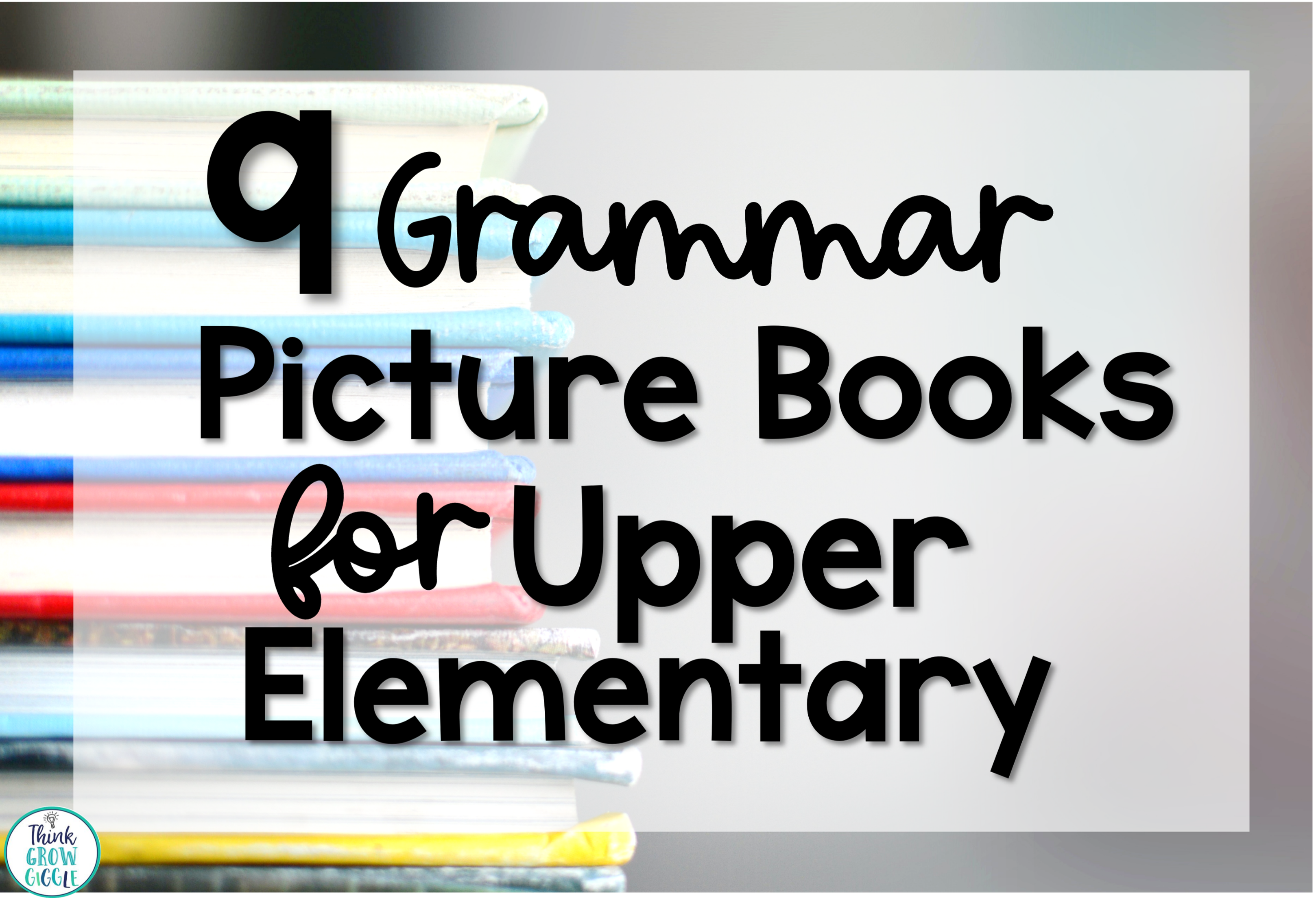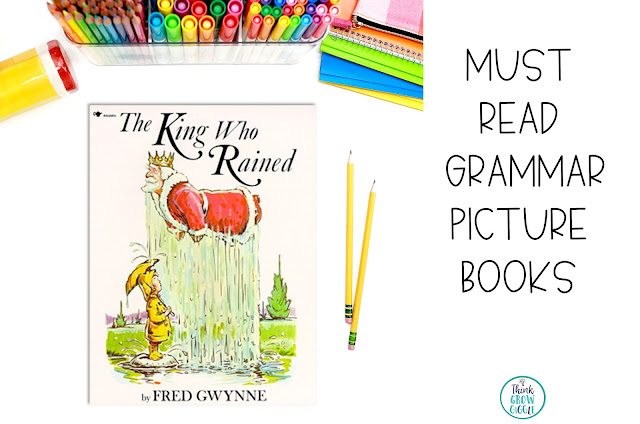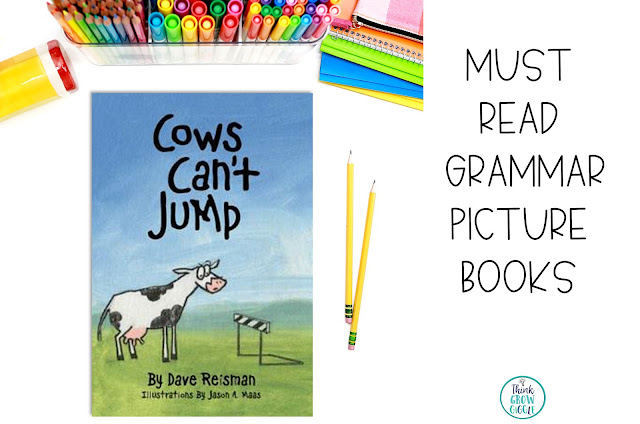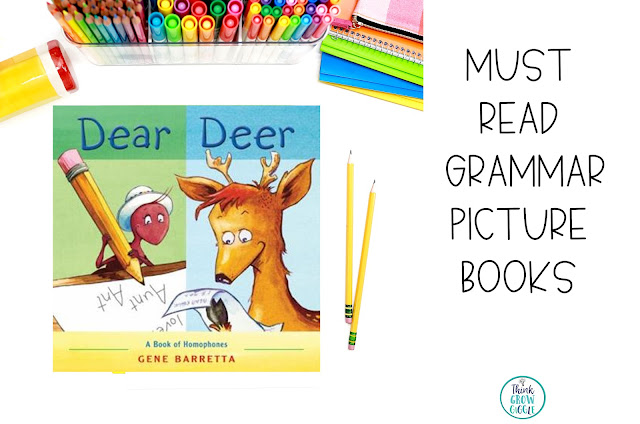Ahh, grammar. The never-ending list of rules we need to make interesting enough to be engaging, AND find the time to make sure we get it into our daily schedule!
Luckily, there is a multitude of amazing picture books to reinforce these grammar rules, engage students, and help us make sure we are addressing important grammar skills each week. There really is no better way to introduce, teach, and review important grammar skills than with an engaging picture book.
While you can read just about any picture book and pull out mentor sentences and examples of grammar rules in action, the following picture books are must-reads for any upper elementary classroom when focusing on specific grammar rules.
1. The King Who Rained: written by Fred Gwynn
Although
it’s a little older (I read this back in elementary school as a student) it is one of my favorites. The illustrations are perfect for creating
a visual understanding of homophones and homonyms. Challenge the kids to come up with their own
hilarious “daddy says” homophone, and put them together in a class book to
enjoy. The illustrations truly make the book memorable, solidifying this tricky concept for students.
2. Cows Can’t Jump: written by Dave Reisman
In this
simple book, readers are introduced to a wide array of very diverse and richly
dynamic verbs. Verbs like “saunter” and “slink” can spark great
conversations about how vivid verbs can transform students' writing pieces. The class
will enjoy defining (even acting out) these interesting verbs. A read-aloud of this book can be
expanded into a research project to determine if these facts are true or not
true about each animal.
3. Chicken In the City: written by Maria Fleming
There is no
shortage of cuteness in this book, and that is only one of the reasons I love
it! The idea of a chicken throwing her corn kernels in a suitcase, grabbing
her pearl necklace, and heading to the big city just makes me giggle a little
every time. This book is great for so many reasons, but it is the perfect noun
resource. Some of the pages are explicitly labeled with nouns. Another reason it
shines and has to be on the top grammar picture book list is that there is a change of
setting. You see the array of farm nouns, and then she heads to the city and
there are nouns there too. This opens the door for a great compare and contrast
opportunity. Make it extra fun by turning the circles of your Venn diagram into oval eggs! Or keep it simple and have your students create a list of nouns that they see in their classroom or at home!
Once that basic noun knowledge has been activated, there are some books that are perfect for diving into the different categories of nouns. When you want to talk about collective nouns, this is a go-to book. It’s engaging in that it introduces students to animal groups they may not be familiar with, and who doesn't love hearing new animal facts? Extend this book read by having students name their family as a collective noun. A _____ of Smith’s, Wilson’s, Brown’s, etc. Go one step further and have them explain and defend the collective noun they choose to use.
Try these free and engaging noun activities to help you get in grammar this year!
5. Pig, Pigger, Piggest: written by Rick Walton
Adjectives are one of the most colorful grammar units to teach, and when you specify with superlatives, it can be even more fun! The illustrations alone are worth this read- the three pig brothers make me laugh every time I look through it. As you read this book, guide students to describe the pigs in great detail, emphasizing that superlative detail in the Piggest Pig of all. Extending this with a simple art project is so much fun! Have students draw three circles with three objects. In each circle, have your students draw a picture of objects to match a given superlative set of adjectives: small, smaller, smallest or try yummy, yummier, yummiest. Students love this activity and get more creative with each illustration.
6. Dear Deer: written by Gene Barretta
7. Hairy, Scary, Ordinary: What is an Adjective: written by Brian P. Cleary
8. Eats, Shoots, and Leaves: written by Lynne Truss
Comma usage is always so tricky for students! This read-aloud will help your students understand the why commas are so important to use as writers. The author writes two different sentences, one with a comma and one without. The illustrations truly help the students see how different the meaning of the sentence becomes when you forget to use that comma! This book will help to make teaching students how to use commas correctly an important part of your punctuation and grammar lessons!
9. Semicolons, Cupcakes, and Cucumbers: written by Steve Newberry
This fun read-aloud follows different punctuation marks as they have a conversation showing off how they work! I love that commas and semicolons are included in this book. As you read this book, be sure to change your voice and expression to match each punctuation mark, to truly help students see how punctuation is not only important to them as writers, but also as readers. Invite students up to help you "act out" this read-aloud, taking on the role of the different punction marks. Grab a free activity to use with this book right HERE.
Add these books to your grammar units for instant engagement and memorable lessons for your students! You will find that by using grammar skill-specific and focused picture books students will understand the skills better and independently apply the strategies they learned to their own writing.
Looking for more meaningful grammar activities for your students? Try these!
You will love reading these related articles:

























